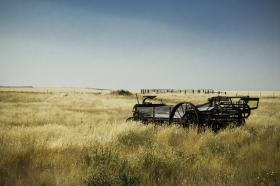Plowing prairies for grains

Clearing grasslands to make way for biofuels may seem counterproductive, but University of Wisconsin-Madison researchers show in a study today (April 2, 2015) that crops, including the corn and soy commonly used for biofuels, expanded onto 7 million acres of new land in the U.S. over a recent four-year period, replacing millions of acres of grasslands.
The study -- from UW-Madison graduate student Tyler Lark, geography Professor Holly Gibbs, and postdoctoral researcher Meghan Salmon -- is published in the journal Environmental Research Letters and the debate over whether the recent boom in demand for common biofuel crops has led to the carbon-emitting conversion of natural areas. It also reveals loopholes in U.S. policies that may contribute to these unintended consequences.
"We realized there was remarkably limited information about how croplands have expanded across the United States in recent years," says Lark, the lead of the study. "Our results are surprising because they show large-scale conversion of new landscapes, which most people didn't expect."
The conversion to corn and soy alone, the researchers say, could have emitted as much carbon dioxide into the as 34 coal-fired power plants operating for one year -- the equivalent of 28 million more cars on the road.
The study is the first comprehensive analysis of land-use change across the U.S. between 2008 and 2012, in the "critical time period" following passage of the federal Renewable Fuel Standard (RFS), and during a "new era" of agriculture and biofuel demand, Lark and Gibbs say. The results may aid policymakers as Congress debates whether to reform or repeal parts of the RFS, which requires blending of gasoline with biofuels that are supposed to be grown only on pre-existing cropland, in order to minimize land-use change and its associated greenhouse gas emissions.
Lark recently visited Washington, D.C., to present the findings to the Environmental Protection Agency and the White House Office of Management and Budget, which share responsibility for rule-making and review of the RFS.
For instance, the study found that 3.5 million acres of corn and soy grown during this time period was produced on new, rather than pre-existing, cropland, rendering it potentially ineligible for renewable fuel production under the RFS. However, this went undetected due to limitations in current federal monitoring, which captures only national-level, aggregate land-use change rather than the high-resolution changes found in the study.
Continue reading at EurekAlert!
Prairie image via Shutterstock.
2015©. Copyright Environmental News Network